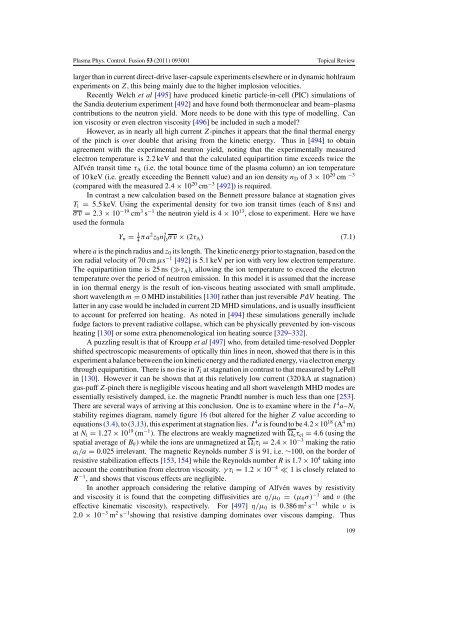Create successful ePaper yourself
Turn your PDF publications into a flip-book with our unique Google optimized e-Paper software.
Plasma Phys. Control. Fusion 53 (2011) 093001<br />
Topical Review<br />
larger than in current direct-drive laser-capsule experiments elsewhere or in dynamic hohlraum<br />
experiments on Z, this being mainly due to <strong>the</strong> higher implosion velocities.<br />
Recently Welch et al [495] have produced kinetic particle-in-cell (PIC) simulations <strong>of</strong><br />
<strong>the</strong> Sandia deuterium experiment [492] and have found both <strong>the</strong>rmonuclear and beam–plasma<br />
contributions to <strong>the</strong> neutron yield. More needs to be done with this type <strong>of</strong> modelling. Can<br />
ion viscosity or even electron viscosity [496] be included in such a model?<br />
However, as in nearly all high current Z-<strong>pinch</strong>es it appears that <strong>the</strong> final <strong>the</strong>rmal energy<br />
<strong>of</strong> <strong>the</strong> <strong>pinch</strong> is over double that arising from <strong>the</strong> kinetic energy. Thus in [494] to obtain<br />
agreement with <strong>the</strong> experimental neutron yield, noting that <strong>the</strong> experimentally measured<br />
electron temperature is 2.2 keV and that <strong>the</strong> calculated equipartition time exceeds twice <strong>the</strong><br />
Alfvén transit time τ A (i.e. <strong>the</strong> total bounce time <strong>of</strong> <strong>the</strong> plasma column) an ion temperature<br />
<strong>of</strong> 10 keV (i.e. greatly exceeding <strong>the</strong> Bennett value) and an ion density n D <strong>of</strong> 3 × 10 20 cm −3<br />
(compared with <strong>the</strong> measured 2.4 × 10 20 cm −3 [492]) is required.<br />
In contrast a new calculation based on <strong>the</strong> Bennett pressure balance at stagnation gives<br />
T i = 5.5 keV. Using <strong>the</strong> experimental density for two ion transit times (each <strong>of</strong> 8 ns) and<br />
σv = 2.3 × 10 −19 cm 3 s −1 <strong>the</strong> neutron yield is 4 × 10 13 , close to experiment. Here we have<br />
used <strong>the</strong> formula<br />
Y n = 1 4 πa2 z 0 n 2 D σv × (2τ A) (7.1)<br />
where a is <strong>the</strong> <strong>pinch</strong> radius and z 0 its length. The kinetic energy prior to stagnation, based on <strong>the</strong><br />
ion radial velocity <strong>of</strong> 70 cm µs −1 [492] is 5.1 keV per ion with very low electron temperature.<br />
The equipartition time is 25 ns (≫τ A ), allowing <strong>the</strong> ion temperature to exceed <strong>the</strong> electron<br />
temperature over <strong>the</strong> period <strong>of</strong> neutron emission. In this model it is assumed that <strong>the</strong> increase<br />
in ion <strong>the</strong>rmal energy is <strong>the</strong> result <strong>of</strong> ion-viscous heating associated with small amplitude,<br />
short wavelength m = 0 MHD instabilities [130] ra<strong>the</strong>r than just reversible P dV heating. The<br />
latter in any case would be included in current 2D MHD simulations, and is usually insufficient<br />
to account for preferred ion heating. As noted in [494] <strong>the</strong>se simulations generally include<br />
fudge factors to prevent radiative collapse, which can be physically prevented by ion-viscous<br />
heating [130] or some extra phenomenological ion heating source [329–332].<br />
A puzzling result is that <strong>of</strong> Kroupp et al [497] who, from detailed time-resolved Doppler<br />
shifted spectroscopic measurements <strong>of</strong> optically thin lines in neon, showed that <strong>the</strong>re is in this<br />
experiment a balance between <strong>the</strong> ion kinetic energy and <strong>the</strong> radiated energy, via electron energy<br />
through equipartition. There is no rise in T i at stagnation in contrast to that measured by LePell<br />
in [130]. However it can be shown that at this relatively low current (320 kA at stagnation)<br />
gas-puff Z-<strong>pinch</strong> <strong>the</strong>re is negligible viscous heating and all short wavelength MHD modes are<br />
essentially resistively damped, i.e. <strong>the</strong> magnetic Prandtl number is much less than one [253].<br />
There are several ways <strong>of</strong> arriving at this conclusion. One is to examine where in <strong>the</strong> I 4 a–N i<br />
stability regimes diagram, namely figure 16 (but altered for <strong>the</strong> higher Z value according to<br />
equations (3.4), to (3.13), this experiment at stagnation lies. I 4 a is found to be 4.2×10 18 (A 4 m)<br />
at N i = 1.27 × 10 19 (m −1 ). The electrons are weakly magnetized with e τ ei = 4.6 (using <strong>the</strong><br />
spatial average <strong>of</strong> B θ ) while <strong>the</strong> ions are unmagnetized at i τ i = 2.4 × 10 −3 making <strong>the</strong> ratio<br />
a i /a = 0.025 irrelevant. The magnetic Reynolds number S is 91, i.e. ∼100, on <strong>the</strong> border <strong>of</strong><br />
resistive stabilization effects [153, 154] while <strong>the</strong> Reynolds number R is 1.7 × 10 4 taking into<br />
account <strong>the</strong> contribution from electron viscosity. γτ i = 1.2 × 10 −4 ≪ 1 is closely related to<br />
R −1 , and shows that viscous effects are negligible.<br />
In ano<strong>the</strong>r approach considering <strong>the</strong> relative damping <strong>of</strong> Alfvén waves by resistivity<br />
and viscosity it is found that <strong>the</strong> competing diffusivities are η/µ 0 = (µ 0 σ) −1 and ν (<strong>the</strong><br />
effective kinematic viscosity), respectively. For [497] η/µ 0 is 0.386 m 2 s −1 while ν is<br />
2.0 × 10 −3 m 2 s −1 showing that resistive damping dominates over viscous damping. Thus<br />
109














